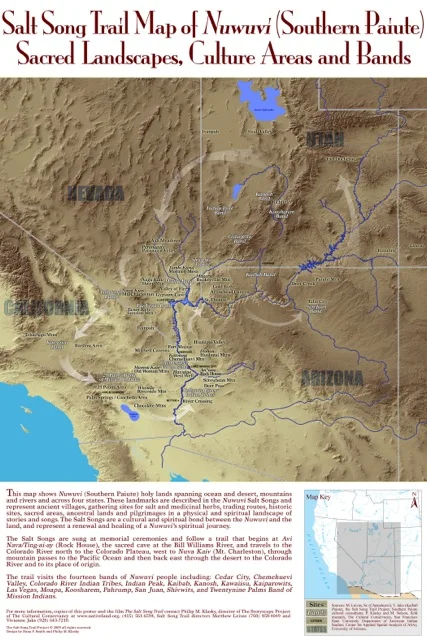The Salt Song Trail Map: the Sacred Landscape of the Nuwuvi People
The Salt Song Trail Map: the Sacred Landscape of the Nuwuvi People
“The Salt Songs are a cultural and spiritual bond between the Nuwuvi and the land, and represent a renewal and a healing spiritual journey.”Vivienne Jake (Kaibab Paiute)
The Salt Song Map Project is a collaboration between the Storyscape Project of The Cultural Conservancyand the Salt Song Trail Project directed by native scholars Vivienne Caron Jake (Kaibab Paiute) and Matthew Leivas, Sr. (Chemehuevi).
The Salt Songs are the sacred songs of the Nuwuvi people and describe a physical and spiritual landscape spanning ocean and desert, mountains and rivers, life and death. The landmarks identified on the map are described by the songs and represent ancient villages, gathering sites for salt and medicinal herbs, trading routes, historic events, sacred areas, and cultural landscapes. At memorial ceremonies, Salt Song singers “throwing the gourd” are accompanied by dancers as they perform the 142 song cycle from sunset to sunrise to assist the deceased in their sacred journey.
The Salt Songs begin their journey at Avi Nava/Ting-ai-ay (Rock House), a sacred cave at the confluence of the Bill Williams and Colorado Rivers. The songs travel north along the Colorado River to the Kaibab and Colorado Plateau, into Southern Utah, and then west to the great mountain Nuva Kaiv(Mt. Charleston) -- the place of origination of the Nuwuvi people -- and then further west to rise above the Pacific Ocean before arcing back east through the Mojave desert to their origin at Avi Nava.
The preservation and revitalization of the Salt Songs has been the life work of Vivienne Jake and Matthew Leivas. In 1998, they invited The Storyscape Project to conduct audio recordings of thirteen singers led by 89 year-old Willis Mayo (Kaibab Paiute) performing the entire song cycle for use by the Nuwuvito teach new generations of singers. The next phase of the project was the production of a documentary film that recorded a ceremony at the site of the Sherman Indian Boarding School in Riverside, California.
Our next project was a program of documentary film training for the Nuwuviand the recording of ceremonies at the site of the Stewart Indian Boarding School in Carson City, Nevada, and at the Old Woman Mountains, an eco-cultural reserve in the Mojave Desert established by the Native American Land Conservancy.
At the gathering at the Old Woman Mountains, the Salt Song singers invited Cahuilla Bird Song Singers to perform in recognition of their shared relationship with a cultural landscape. The resulting film, The Salt Song Trail: Living Documentary, was edited by Chemehuevi filmmakers Cara McCoy and Bridget Sandate and is a continuation of the chronicle of the Salt Song Trail.
In our work at The Cultural Conservancy, we recognize the connection between cultural preservation and environmental protection. The Salt Song Trail map is an example of cultural cartography developed through participatory action research with native communities. This kind of mapping establishes a historical record and cultural identity that fosters stewardship of the land.
Current laws and land use management policies fail to protect cultural resources and native peoples are constantly battling to protect their ancestral lands from resource extraction and other forms of environmental destruction. By documenting their sacred landscapes, indigenous peoples are attempting to defend their land rights and reach across cultural divides to assert value systems that are more profound and far-sighted than the onslaught of exploitation.
The multi-dimensional map invites our engagement with the land. The exquisite design and patterns of the earth from satellite photographs are portrayed through a textured relief that gives form to the cultural teachings of the Nuwuvi. The 2’ by 3’ poster will be proudly displayed in kitchens and living rooms, at preschools and senior centers, in health clinics and tribal headquarters. The map is a way to display cultural pride, traditional knowledge and survivance – the healing transformation that occurs through cultural revitalization and the continued resistance to colonialism.

